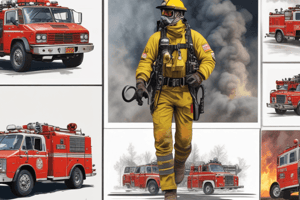Podcast
Questions and Answers
What is the primary purpose of effective communication in a team?
What is the primary purpose of effective communication in a team?
- To assign blame during conflicts.
- To increase the number of meetings held.
- To ensure all members agree on every decision.
- To facilitate understanding and collaboration among team members. (correct)
Which of the following best describes active listening?
Which of the following best describes active listening?
- Fully concentrating, understanding, responding, and remembering what is being said. (correct)
- Waiting for your turn to speak without engaging with the speaker.
- Pretending to listen while thinking of a response.
- Nodding occasionally to show agreement.
What could be a negative consequence of poor communication in a workplace?
What could be a negative consequence of poor communication in a workplace?
- Increased misunderstandings and conflict. (correct)
- Increased productivity among team members.
- More creative solutions to problems.
- Stronger relationships among coworkers.
Which of the following strategies can enhance team communication?
Which of the following strategies can enhance team communication?
What role does non-verbal communication play in team interactions?
What role does non-verbal communication play in team interactions?
Flashcards
Record
Record
A set of related information about a single thing, such as a person, place, or event.
Database
Database
A collection of records, often organized in a specific way to make it easy to find what you need.
Query
Query
A query is a question or request sent to a database to retrieve specific information.
SQL
SQL
Signup and view all the flashcards
Field
Field
Signup and view all the flashcards
Study Notes
Tulsa Fire Department - Emergency Operating Guidelines
- Section 300 - Strategic and Tactical Considerations outlines incident response guidelines and considerations for the Tulsa Fire Department (TFD).
- Individual subject purpose statements are omitted for brevity and because the intent is considered basic firefighter knowledge.
- The guidelines and referenced materials are adopted as TFD policy.
- TFD members are expected to follow the spirit and intent of the guidelines, recognizing each incident is unique.
- Personnel positions listed in the guidelines apply equally to acting counterparts.
Table of Contents
-
300.1 Prefix:
- Purpose
- Policy Statement
- Table of Contents (further details follow in subsequent pages)
-
300.2 Fire Response:
- Apparatus Placement Considerations
- Engine Placement Considerations
- Ladder Placement Considerations
- Engine/Ladder Primary Functions
- Engine Company Operations
- Ladder Company Operations
- Incident Stabilization Functions
- Property Conservation Tasks
- All Companies
- Structural Incidents
- Structure Fire Guidelines
- Tactical Priorities
- Rescue Size-Up
-
300.3 Transportation Related Response:
- Expressways - Converging Approach
- Traffic Safety
-
300.4 EMS Response:
- On Scene Chain-of-Command
- Patient Care Protocols
- Scene Safety
- Accurate Incident Times
-
300.5 Utility Control/Utility Responses:
- Residential Utility Shut-Off
-
300.6 Special Operations Response:
- ARFF
- Response Procedures
- Jenks Fire
- Tulsa Fire
- Hazardous Materials Response (Further specifics on topics in 300 are in the following pages)
- ARFF
-
300.7 Response to Fire Alarm System Activation:
- Residential Fire Alarms
- Business Fire Alarms
- Water Flow and/or Multiple Trips
- Repeat Alarms
-
300.8 Public Service/Community Considerations:
- Non-Emergency Response Policy
- Access Into Locked Vehicles
- Assist TPD
- Assist Citizen/Motorist
- Responding to Incidents Involving Animals
- Non-Emergency Response Policy
-
300.9 Catastrophic Event and Disaster Response:
- Storm/Disaster Response Guidelines
- Pre-Storm Procedures
- Post-Storm Procedures
- Rapid Damage Assessment
-
300.10 Air Support:
- Helicopter Landing Zones
- Helicopter Transport Criteria
- Landing Zone Guidelines
- Ground Procedures
- Hand Signals(pictures attached)
- Helicopter Landing Zones
-
300.2.3 Structural Incidents:
- Structure Fire Guidelines
- Strategic and Tactical Considerations
- SAW CSS RECEO VSS
- Tactical Priorities
- Rescue Size-Up
-
300.2.4 Other Fire Incidents:
- Vehicle Fires
- Dangers/Precautions
-
(Other Sections): Includes further topics like 300.5.2 Electrical System Response and 300.2.3 Structural Incidents
-
This is a broad overview, further detail on each subsection is provided in the following pages.
-
Some sections have subheadings and detailed information, as seen in the contents list.
Studying That Suits You
Use AI to generate personalized quizzes and flashcards to suit your learning preferences.




